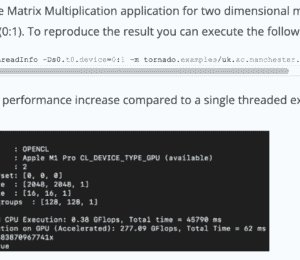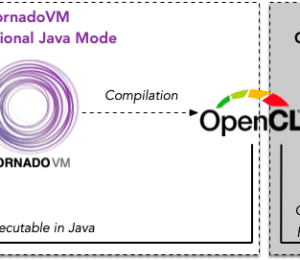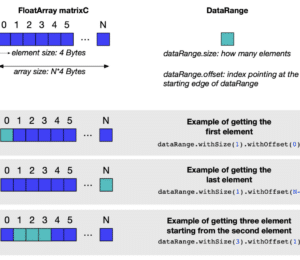TornadoVM for RISC-V Accelerators
- September 19, 2024
- 5157 Unique Views
- 11 min read
Takeaways
- RISC-V is an open standard instruction set architecture that anyone can use to build new processors and accelerators, for example, for AI.
- oneAPI Construction Kit (OCK) is a new framework that allows software developers and system designers to bridge the gap between hardware accelerators and open standards, by enabling a programming system to implement domain specific instructions for modern hardware such as RISC-V accelerators and custom processors.
- TornadoVM, a parallel programming framework for Java, can take advantage of OCK to offload and accelerate Java workloads on RISC-V chips. This post shows how to run on RISC-V CPUs with vector extensions.
Introduction
RISC-V is an open standard instruction set architecture (ISA) based on the principles of reduced instruction sets (RISC). RISC-V is freely available under open licences, allowing anyone to design, modify and implement RISC-V processors.
RISC-V designs are highly modular, and it contains many extensions that system designers can use to build specialised processors (e.g., Security extensions, HPC extensions, Vector extensions, etc).
But, how do we run software on these new and modular processors, and how can we take advantage of future specialised designs for parallelism, deep learning, AI, etc? One way to get this mapping between software and hardware is via the oneAPI Construction Kit.
The oneAPI Construction Kit (OCK) is an open-source programming framework that allows developers to implement operations for new hardware such as RISC-V accelerators. What makes OCK special is that this framework can facilitate developers to map open programming standards, such as SYCL and OpenCL, to new hardware accelerators. With a few configuration files, developers can define the set of operations for the new hardware, and then map those operations to the implementation of open standards like SYCL.
Furthermore, OCK could also be used as a runtime dispatcher of OpenCL and SPIR-V kernels, and this is the interest of this post. We could configure OCK to provide an OpenCL implementation to run on RISC-V cores.
But, can we run Java workloads on these accelerators? Well, with the help of TornadoVM, a parallel programming framework for acceleration of Java workloads, it is possible. This post explains how to configure and install OCK to work as a backend for TornadoVM, allowing Java developers to access CPUs from different vendors, including RISC-V accelerators. Are you curious? Let’s find out how this is possible.
OCK for TornadoVM
OCK is in active development, and it is built based on the LLVM compiler. This post explains how to obtain the main dependencies from source files and Linux systems. All components explained in this post are fully open source.
Installing prerequisites:
If you use Fedora or Red Hat-based distributions, you will need to install the following dependencies.
sudo dnf install dtc ninja doxygen python3-pip git cmake spirv-tools sudo pip3 install lit cmakelint
Installation of OCK for TornadoVM
Let’s configure OCK to run on RISC-V accelerators and use them as devices for TornadoVM. In the case of RISC-V, since I do not have any hardware available, TornadoVM can run on a RISC-V simulator from an X86/64 machine.
To do so, OCK comes with a simulator, called Codeplay Reference Silicon (RefSi), which is based on SPIKE, and it can be used in combination with our Java/TornadoVM programs to run on RISC-V with Vector Instruction extensions! How cool is this?
Installation of LLVM
Configure LLVM for RISC-V as follows:
mkdir ock cd ock baseDIR=$PWD git clone https://github.com/llvm/llvm-project.git llvm cd llvm-project llvmDIR=$PWD
At the time of writing this post, the supported LLVM version for OCK is 18. Thus, we need to configure LLVM using the 18.x branch:
git checkout release/18.x export LLVMINSTALL=$llvmDIR/build-riscv/install cmake llvm -GNinja \ -Bbuild-riscv \ -DCMAKE_BUILD_TYPE=Release \ -DCMAKE_INSTALL_PREFIX=$PWD/build-riscv/install \ -DLLVM_ENABLE_PROJECTS="clang;lld" \ -DLLVM_TARGETS_TO_BUILD='X86;RISCV' ninja -C build-riscv install
Configuring oneAPI Construction Kit for RISC-V
cd $baseDIR/oneapi-construction-kit cmake -GNinja -Bbuild-riscv \ -DCA_RISCV_ENABLED=ON \ -DCA_MUX_TARGETS_TO_ENABLE="riscv" \ -DCA_LLVM_INSTALL_DIR=$llvmDIR/build-riscv/install \ -DCA_ENABLE_HOST_IMAGE_SUPPORT=OFF \ -DCA_ENABLE_API=cl \ -DCA_CL_ENABLE_ICD_LOADER=ON \ -DCMAKE_INSTALL_PREFIX=$PWD/build-riscv/install ninja -C build-riscv install
Next, we need to configure the Linux system to use the new OpenCL installation. There are various ways to get this. One of them is updating the folder /etc/OpenCL/vendors/ with a new file that contains the path to the libCL.so installation.
sudo vim /etc/OpenCL/vendors/ock.icd
And we add the following line to the file: use your absolute path to the libCL.so file.
/home/juan/repos/ock/oneapi-construction-kit/build-x86_64/install/lib/libCL.so
Installing TornadoVM
We are now ready to install TornadoVM. Note that, if you have TornadoVM already installed, there is no need to reconfigure it. TornadoVM will detect the new device automatically. The following line installs TornadoVM to use the OpenCL backend.
cd TORNADOVM_ROOT ./bin/tornadovm-installer --jdk jdk21 --backend=opencl source setvars.sh
Let’s explore all devices available:
tornado --devices
And we will get the following output. Note that the number of devices and the ordering depends on your local configuration. In my case, I have two GPUs that can be used with the OpenCL backend, namely an NVIDIA RTX 3070 and an Intel Integrated GPU (UHD 770). Additionally, we get a new device called RefSi G1 RV64. This is our RISC-V device we have just configured with OCK.
Number of Tornado drivers: 1
Driver: OpenCL
Total number of OpenCL devices : 3
Tornado device=0:0 (DEFAULT)
OPENCL -- [NVIDIA CUDA] -- NVIDIA GeForce RTX 3070
Global Memory Size: 7.8 GB
Local Memory Size: 48.0 KB
Workgroup Dimensions: 3
Total Number of Block Threads: [1024]
Max WorkGroup Configuration: [1024, 1024, 64]
Device OpenCL C version: OpenCL C 1.2
Tornado device=0:1
OPENCL -- [Intel(R) OpenCL Graphics] -- Intel(R) UHD Graphics 770
Global Memory Size: 28.8 GB
Local Memory Size: 64.0 KB
Workgroup Dimensions: 3
Total Number of Block Threads: [512]
Max WorkGroup Configuration: [512, 512, 512]
Device OpenCL C version: OpenCL C 1.2
Tornado device=0:2
OPENCL -- [ComputeAorta] -- RefSi G1 RV64 << RISC-V OpenCL Device
Global Memory Size: 2.0 GB
Local Memory Size: 256.0 KB
Workgroup Dimensions: 3
Total Number of Block Threads: [1024]
Max WorkGroup Configuration: [1024, 1024, 1024]
Device OpenCL C version: OpenCL C 1.2 Clang 18.1.8
The RefSi G1 RV64 device runs on a simulator. Let’s run an example, a simple vector addition to illustrate the usage of TornadoVM on RISC-V with some debug information tell us which device was used.
The Java example used is available on GitHub and it is described as follows:
public static void add(IntArray a, IntArray b, IntArray c) {
for (@Parallel int i = 0; i < c.getSize(); i++) {
c.set(i, a.get(i) + b.get(i));
}
}
public static void main(String[] args) throws TornadoExecutionPlanException {
final int numElements = 8;
IntArray a = new IntArray(numElements);
IntArray b = new IntArray(numElements);
IntArray c = new IntArray(numElements);
a.init(1);
b.init(2);
c.init(0);
TaskGraph taskGraph = new TaskGraph("s0") //
.transferToDevice(DataTransferMode.FIRST_EXECUTION, a, b) //
.task("t0", ArrayAddInt::add, a, b, c) //
.transferToHost(DataTransferMode.EVERY_EXECUTION, c);
ImmutableTaskGraph immutableTaskGraph = taskGraph.snapshot();
try (TornadoExecutionPlan executor = new TornadoExecutionPlan(immutableTaskGraph)) {
executor.execute();
}
System.out.println("a: " + Arrays.toString(a.toHeapArray()));
System.out.println("b: " + Arrays.toString(b.toHeapArray()));
System.out.println("c: " + Arrays.toString(c.toHeapArray()));
}
The add method is the actual method to be accelerated on the RISC-V device. Note that, in the Java code, there is no information about which device to use, how to offload or which backend to use. TornadoVM will perform compilation, data handling and runtime scheduling automatically.
To run the application:
tornado --jvm="-Ds0.t0.device=0:2" --threadInfo -m tornado.examples/uk.ac.manchester.tornado.examples.arrays.ArrayAddInt
And the output:
Task info: s0.t0
Backend : OPENCL
Device : RefSi G1 RV64 CL_DEVICE_TYPE_ACCELERATOR (available)
Dims : 1
Global work offset: [0]
Global work size : [8]
Local work size : [8, 1, 1]
Number of workgroups : [1]
a: [1, 1, 1, 1, 1, 1, 1, 1]
b: [2, 2, 2, 2, 2, 2, 2, 2]
c: [3, 3, 3, 3, 3, 3, 3, 3]
We just offloaded a Java method to a RISC-V accelerator! This example is a simple vector addition, and, as we can see from the task-info, the device selected was a RISC-V with RVV vector extensions. We can go a step further and emit the RISC-V assembly code for our generated OpenCL kernel. Todo do so, we need to reconfigure OCK with debug information enabled using -DCA_ENABLE_DEBUG_SUPPORT=ON -DCA_DEBUG_SUPPORT=ON as follows:
cmake -GNinja -Bbuild-riscv-debug \ -DCA_ENABLE_DEBUG_SUPPORT=ON \ -DCA_DEBUG_SUPPORT=ON \ -DCA_RISCV_ENABLED=ON \ -DCA_MUX_TARGETS_TO_ENABLE="riscv" \ -DCA_LLVM_INSTALL_DIR=$llvmDIR/build-riscv/install \ -DCA_ENABLE_HOST_IMAGE_SUPPORT=OFF \ -DCA_ENABLE_API=cl \ -DCA_CL_ENABLE_ICD_LOADER=ON \ -DCMAKE_INSTALL_PREFIX=$PWD/build-riscv-debug/install ninja -C build-riscv-debug install
Then, before we run TornadoVM, we need to export the following env variable:
export CA_RISCV_DUMP_ASM=1 ## Print Assembly code
We run the same application:
tornado --jvm="-Ds0.t0.device=0:2" --threadInfo -m tornado.examples/uk.ac.manchester.tornado.examples.arrays.ArrayAddInt
And we will obtain the following output:
.text
.attribute 4, 16
.attribute 5, "rv64i2p1_m2p0_a2p1_f2p2_d2p2_c2p0_v1p0_zicsr2p0_zve32f1p0_zve32x1p0_zve64d1p0_zve64f1p0_zve64x1p0_zvl128b1p0_zvl32b1p0_zvl64b1p0"
.file "kernel.opencl"
.globl "add.mux-kernel-wrapper"
.p2align 1
.type "add.mux-kernel-wrapper",@function
"add.mux-kernel-wrapper":
addi sp, sp, -80
sd ra, 72(sp)
sd s0, 64(sp)
sd s2, 56(sp)
sd s3, 48(sp)
sd s4, 40(sp)
sd s5, 32(sp)
sd s6, 24(sp)
sd s7, 16(sp)
sd s8, 8(sp)
sd s9, 0(sp)
addi s0, sp, 80
andi sp, sp, -16
li a7, 0
ld t4, 32(a0)
ld t3, 40(a0)
ld t2, 48(a0)
ld s2, 72(a1)
ld t0, 80(a1)
ld a0, 0(a1)
ld a2, 24(a1)
ld a6, 88(a1)
ld s4, 48(a1)
mul s3, a0, s2
mulw s8, s2, a2
addi t2, t2, 24
addw t1, s4, s3
slli s9, s8, 2
addi t3, t3, 24
addi t4, t4, 24
li t5, 7
li s5, 8
j .LBB0_2
.LBB0_1:
addi a7, a7, 1
beq a7, a6, .LBB0_9
.LBB0_2:
li t6, 0
j .LBB0_4
.LBB0_3:
addi t6, t6, 1
beq t6, t0, .LBB0_1
.LBB0_4:
li s7, 0
mv s6, t1
j .LBB0_6
.LBB0_5:
addi s7, s7, 1
addiw s6, s6, 1
beq s7, s2, .LBB0_3
.LBB0_6:
add a5, s3, s7
addw a1, a5, s4
blt t5, a1, .LBB0_5
slli a1, s6, 2
add a4, t2, a1
add a3, t3, a1
add a1, a1, t4
addw a5, a5, s4
.LBB0_8:
lw a0, 0(a1)
lw a2, 0(a3)
add a0, a0, a2
sw a0, 0(a4)
add a5, a5, s8
add a4, a4, s9
add a3, a3, s9
add a1, a1, s9
blt a5, s5, .LBB0_8
j .LBB0_5
.LBB0_9:
addi sp, s0, -80
ld ra, 72(sp)
ld s0, 64(sp)
ld s2, 56(sp)
ld s3, 48(sp)
ld s4, 40(sp)
ld s5, 32(sp)
ld s6, 24(sp)
ld s7, 16(sp)
ld s8, 8(sp)
ld s9, 0(sp)
addi sp, sp, 80
ret
.Lfunc_end0:
.size "add.mux-kernel-wrapper", .Lfunc_end0-"add.mux-kernel-wrapper"
.type notes_global,@object
.section notes,"a",@progbits
.globl notes_global
notes_global:
.asciz
…
.size notes_global, 192
.ident "clang version 18.1.8 (https://github.com/llvm/llvm-project.git 3b5b5c1ec4a3095ab096dd780e84d7ab81f3d7ff)"
.section ".note.GNU-stack","",@progbits
Task info: s0.t0
Backend : OPENCL
Device : RefSi G1 RV64 CL_DEVICE_TYPE_ACCELERATOR (available)
Dims : 1
Global work offset: [0]
Global work size : [8]
Local work size : [8, 1, 1]
Number of workgroups : [1]
This is the RISC-V code for our example, that was executed with the RefSi RISC-V Simulator from Codeplay. However, if we pay attention, there are no RISC-V Vector (RVV) instructions being generated. This is because we need to export the following variable with the vector width:
export CA_RISCV_VF=4
If we run TornadoVM again with the OCK debug information on, we obtain the following:
tornado --jvm="-Ds0.t0.device=0:2" --threadInfo -m tornado.examples/uk.ac.manchester.tornado.examples.arrays.ArrayAddInt
[ ASSEMBLY code … ]
.LBB0_18:
add a0, s5, s8
add a0, a0, s4
vsetvli zero, zero, e64, m2, ta, ma
vadd.vx v10, v8, a0
vsetvli zero, zero, e32, m1, ta, ma
vnsrl.wi v12, v10, 0
vmsle.vi v0, v12, 7
vsetvli zero, zero, e8, mf4, ta, ma
vmv.x.s a0, v0
andi a0, a0, 15
beqz a0, .LBB0_17
slli a3, s7, 2
add a2, t3, a3
add a0, t4, a3
add a3, a3, t6
vsetvli zero, zero, e64, m2, ta, ma
vsll.vx v10, v10, s2
vsra.vx v10, v10, s2
.LBB0_20:
vsetvli zero, zero, e32, m1, ta, ma
vle32.v v12, (a3), v0.t
vle32.v v13, (a0), v0.t
vadd.vv v12, v13, v12
vse32.v v12, (a2), v0.t
vsetvli zero, zero, e64, m2, ta, ma
vadd.vx v10, v10, s9
vmsle.vi v12, v10, 7
vmand.mm v0, v12, v0
vsetvli zero, zero, e8, mf4, ta, ma
vmv.x.s a4, v0
andi a4, a4, 15
add a2, a2, a5
add a0, a0, a5
add a3, a3, a5
bnez a4, .LBB0_20
j .LBB0_17
.Lfunc_end0:
.size "__vecz_v4_add.mux-kernel-wrapper", .Lfunc_end0-"__vecz_v4_add.mux-kernel-wrapper"
.type notes_global,@object
.section notes,"a",@progbits
.globl notes_global
notes_global:
.asciz
[ … ]
.size notes_global, 200
.ident "clang version 18.1.8 (https://github.com/llvm/llvm-project.git 3b5b5c1ec4a3095ab096dd780e84d7ab81f3d7ff)"
.section ".note.GNU-stack","",@progbits
Task info: s0.t0
Backend : OPENCL
Device : RefSi G1 RV64 CL_DEVICE_TYPE_ACCELERATOR (available)
Dims : 1
Global work offset: [0]
Global work size : [8]
Local work size : [8, 1, 1]
Number of workgroups : [1]
And, if we export the following variable:
export SPIKE_SIM_DEBUG=1
We can even run step by step with a debugger that is included within the RefSi Simulator. How cool is this?
Running with the SPIR-V Backend on RISC-V Devices
TornadoVM, as in version 1.0.7, supports three different backends: OpenCL, NVIDIA PTX and SPIR-V. When using OCK, we can program devices in OpenCL C, and SPIR-V. So far, we have only used the SPIR-V backend, so how do we also enable the SPIR-V backend? What we need to do is to reconfigure TornadoVM to also use SPIR-V devices.
./bin/tornadovm-installer --jdk jdk21 --backend=opencl,spirv source setvars.sh
Then, we can query all accelerators that TornadoVM can run with the following command:
tornado --devices
And we get the following output:
Number of Tornado drivers: 2
Driver: SPIR-V
Total number of SPIR-V devices : 2
Tornado device=0:0 (DEFAULT)
SPIRV -- SPIRV OCL - Intel(R) UHD Graphics 770
Global Memory Size: 28.8 GB
Local Memory Size: 64.0 KB
Workgroup Dimensions: 3
Total Number of Block Threads: [512]
Max WorkGroup Configuration: [512, 512, 512]
Device OpenCL C version: OpenCL C 1.2
Tornado device=0:1
SPIRV -- SPIRV LevelZero - Intel(R) UHD Graphics 770
Global Memory Size: 28.8 GB
Local Memory Size: 64.0 KB
Workgroup Dimensions: 3
Total Number of Block Threads: [512]
Max WorkGroup Configuration: [512, 512, 512]
Device OpenCL C version: (LEVEL ZERO) 1.3
Driver: OpenCL
Total number of OpenCL devices : 3
Tornado device=1:0
OPENCL -- [NVIDIA CUDA] -- NVIDIA GeForce RTX 3070
Global Memory Size: 7.8 GB
Local Memory Size: 48.0 KB
Workgroup Dimensions: 3
Total Number of Block Threads: [1024]
Max WorkGroup Configuration: [1024, 1024, 64]
Device OpenCL C version: OpenCL C 1.2
Tornado device=1:1
OPENCL -- [Intel(R) OpenCL Graphics] -- Intel(R) UHD Graphics 770
Global Memory Size: 28.8 GB
Local Memory Size: 64.0 KB
Workgroup Dimensions: 3
Total Number of Block Threads: [512]
Max WorkGroup Configuration: [512, 512, 512]
Device OpenCL C version: OpenCL C 1.2
Tornado device=1:2
OPENCL -- [ComputeAorta] -- RefSi G1 RV64
Global Memory Size: 2.0 GB
Local Memory Size: 256.0 KB
Workgroup Dimensions: 3
Total Number of Block Threads: [1024]
Max WorkGroup Configuration: [1024, 1024, 1024]
Device OpenCL C version: OpenCL C 1.2 Clang 18.1.8
The first two devices correspond to devices that can be used to run SPIR-V code. But wait, there is no RISC-V (RefSi) device. Why is this?
RefSi supports SPIR-V 1.0, but TornadoVM requires, at least, SPIR-V 1.2. We can force this by invoking TornadoVM with the following JVM flag:
tornado --jvm="-Dtornado.spirv.version=1.0" --devices
And we will get the following output:
Number of Tornado drivers: 2
Driver: SPIR-V
Total number of SPIR-V devices : 3
Tornado device=0:0 (DEFAULT)
SPIRV -- SPIRV OCL - Intel(R) UHD Graphics 770
Global Memory Size: 28.8 GB
Local Memory Size: 64.0 KB
Workgroup Dimensions: 3
Total Number of Block Threads: [512]
Max WorkGroup Configuration: [512, 512, 512]
Device OpenCL C version: OpenCL C 1.2
Tornado device=0:1
SPIRV -- SPIRV OCL - RefSi G1 RV64
Global Memory Size: 2.0 GB
Local Memory Size: 256.0 KB
Workgroup Dimensions: 3
Total Number of Block Threads: [1024]
Max WorkGroup Configuration: [1024, 1024, 1024]
Device OpenCL C version: OpenCL C 1.2 Clang 18.1.8
Tornado device=0:2
SPIRV -- SPIRV LevelZero - Intel(R) UHD Graphics 770
Global Memory Size: 28.8 GB
Local Memory Size: 64.0 KB
Workgroup Dimensions: 3
Total Number of Block Threads: [512]
Max WorkGroup Configuration: [512, 512, 512]
Device OpenCL C version: (LEVEL ZERO) 1.3
Driver: OpenCL
Total number of OpenCL devices : 3
Tornado device=1:0
OPENCL -- [NVIDIA CUDA] -- NVIDIA GeForce RTX 3070
Global Memory Size: 7.8 GB
Local Memory Size: 48.0 KB
Workgroup Dimensions: 3
Total Number of Block Threads: [1024]
Max WorkGroup Configuration: [1024, 1024, 64]
Device OpenCL C version: OpenCL C 1.2
Tornado device=1:1
OPENCL -- [Intel(R) OpenCL Graphics] -- Intel(R) UHD Graphics 770
Global Memory Size: 28.8 GB
Local Memory Size: 64.0 KB
Workgroup Dimensions: 3
Total Number of Block Threads: [512]
Max WorkGroup Configuration: [512, 512, 512]
Device OpenCL C version: OpenCL C 1.2
Tornado device=1:2
OPENCL -- [ComputeAorta] -- RefSi G1 RV64
Global Memory Size: 2.0 GB
Local Memory Size: 256.0 KB
Workgroup Dimensions: 3
Total Number of Block Threads: [1024]
Max WorkGroup Configuration: [1024, 1024, 1024]
Device OpenCL C version: OpenCL C 1.2 Clang 18.1.8
And we can use this SPIR-V backend and device to run our Java programs with TornadoVM:
tornado --jvm="-Dtornado.spirv.version=1.0 -Ds0.t0.device=0:1" --threadInfo -m tornado.examples/uk.ac.manchester.tornado.examples.arrays.ArrayAddInt
[ ASSEMBLY CODE … ]
.LBB0_20:
slli s1, a5, 2
add a2, s5, s1
vle32.v v10, (a2), v0.t
add a2, s0, s1
vle32.v v11, (a2), v0.t
add s1, s1, a0
vsetvli zero, zero, e32, m1, ta, ma
vadd.vv v10, v11, v10
vse32.v v10, (s1), v0.t
vadd.vx v9, v9, a4
vmsle.vi v10, v9, 7
vmand.mm v0, v10, v0
vsetvli zero, zero, e8, mf4, ta, ma
vmv.x.s a2, v0
andi a2, a2, 15
addw a5, a5, a4
bnez a2, .LBB0_20
[ ASSEMBLY CODE … ]
Task info: s0.t0
Backend : SPIRV
Device : SPIRV OCL - RefSi G1 RV64 FPGA
Dims : 1
Global work offset: [0]
Global work size : [8]
Local work size : [8, 1, 1]
Number of workgroups : [1]
Conclusions
Hardware specialisation is now everywhere and modern computing systems contain a wide range of processors for computing specialised tasks more efficiently, such as processors for AI and deep learning.
However, we also need to program and access new hardware accelerators and exploit their capabilities efficiently. This post has explored a way to do so by using the oneAPI Construction Kit as a driver for the TornadoVM project. This allows Java developers to access modern hardware with no changes to their existing Java/TornadoVM applications.
This post just scratches the surface of the possibilities of execution and optimization of Java programs on modern hardware. I have written a more detailed blogpost in which I also compared OCK on Intel and ARM CPUs with Java threads, and shows the potential for these types of solutions to run on modern and parallel CPUs.
Acknowledgments
I would like to thank Colin Davidson from Codeplay for the support regarding the oneAPI Construction Kit for TornadoVM.
Don’t Forget to Share This Post!













Comments (0)
No comments yet. Be the first.